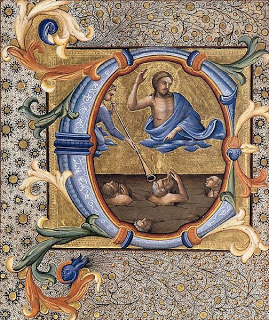Medieval History
 Scientists in the US and Italy have borrowed a technique more usually associated with geophysical remote sensing and applied it to medieval artwork - with stunning results. The near-infrared hyperspectral imaging of a leaf from a 15th century illuminated manuscript has produced a map of the pigment binders used by the artist.
Scientists in the US and Italy have borrowed a technique more usually associated with geophysical remote sensing and applied it to medieval artwork - with stunning results. The near-infrared hyperspectral imaging of a leaf from a 15th century illuminated manuscript has produced a map of the pigment binders used by the artist.
The technique will not only allow conservation specialists to better plan strategies for restoring and stabilising paintings, but will also give art historians new insights into the materials and methods favoured by individual artists. Art historians and conservationists need detailed information about materials used by artists, such as the pigments and the organic binding agents, for example gum Arabic or egg white, which were used to carry the pigment.
In some cases it is possible to remove tiny samples from the artwork for analysis, or to use imaging techniques on a small area of the work. But until now it has been difficult to obtain an overview of the materials used across the work as a whole.
Click here to read this article from Chemistry World
- Art Historian The Influence Of Medieval Pieces On Culture
The job of art historians is to discover the origins of artwork, but when it comes to art from early medieval periods, historians find themselves in a world shrouded in mystery. "We've got objects, but no fancy story to attach to them," said...
- New Scanner To Reveal Hidden Art Works
Painted-over murals were thought to be irretrievably lost because conventional methods are seldom suitable to rendering the hidden works visible without causing damage. Research scientists now aim to reveal the secrets of these paintings non-destructively...
- Ancient Egyptian Blue Found In 12th Century Church
A team of researchers from the University of Barcelona has discovered remains of Egyptian blue in a Romanesque altarpiece in the church of Sant Pere de Terrassa in Barcelona. This blue pigment was used from the days of ancient Egypt until the end of the...
- Laser Surgery Technique Gets New Life In Art Restoration
A laser technique best known for its use to remove unwanted tattoos from the skin is finding a second life in preserving great sculptures, paintings and other works of art, according to an article in the American Chemical Society's monthly journal,...
- Archaic Mark Is A Modern Forgery, Not A Medieval Manuscript
Margaret M. Mitchell of the University of Chicago, together with experts in micro-chemical analysis and medieval bookmaking, has concluded that one of the University Library's most enigmatic possessions is a forgery. Scholars have argued for nearly...
Medieval History
Near-infrared spectroscopy illuminates medieval art

The technique will not only allow conservation specialists to better plan strategies for restoring and stabilising paintings, but will also give art historians new insights into the materials and methods favoured by individual artists. Art historians and conservationists need detailed information about materials used by artists, such as the pigments and the organic binding agents, for example gum Arabic or egg white, which were used to carry the pigment.
In some cases it is possible to remove tiny samples from the artwork for analysis, or to use imaging techniques on a small area of the work. But until now it has been difficult to obtain an overview of the materials used across the work as a whole.
Click here to read this article from Chemistry World
- Art Historian The Influence Of Medieval Pieces On Culture
The job of art historians is to discover the origins of artwork, but when it comes to art from early medieval periods, historians find themselves in a world shrouded in mystery. "We've got objects, but no fancy story to attach to them," said...
- New Scanner To Reveal Hidden Art Works
Painted-over murals were thought to be irretrievably lost because conventional methods are seldom suitable to rendering the hidden works visible without causing damage. Research scientists now aim to reveal the secrets of these paintings non-destructively...
- Ancient Egyptian Blue Found In 12th Century Church
A team of researchers from the University of Barcelona has discovered remains of Egyptian blue in a Romanesque altarpiece in the church of Sant Pere de Terrassa in Barcelona. This blue pigment was used from the days of ancient Egypt until the end of the...
- Laser Surgery Technique Gets New Life In Art Restoration
A laser technique best known for its use to remove unwanted tattoos from the skin is finding a second life in preserving great sculptures, paintings and other works of art, according to an article in the American Chemical Society's monthly journal,...
- Archaic Mark Is A Modern Forgery, Not A Medieval Manuscript
Margaret M. Mitchell of the University of Chicago, together with experts in micro-chemical analysis and medieval bookmaking, has concluded that one of the University Library's most enigmatic possessions is a forgery. Scholars have argued for nearly...
